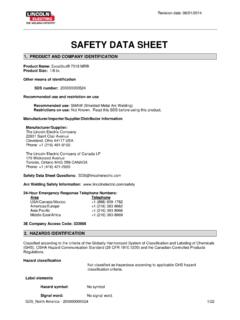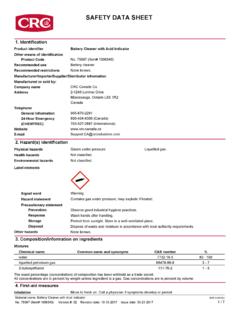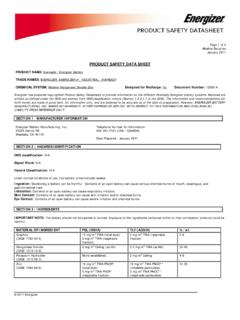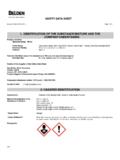Transcription of SAFETY DATA SHEET - MyAutoProducts.com
1 SAFETY data SHEET1. IdentificationProduct identifierSUPERIOR LACQUER THINNERO ther means of identificationProduct CodeST501-1 GRecommended useLacquer ThinnerManufacturer/Importer/Supplier/Di stributor informationManufacturerLiberty Bell Equipment CorporationAddress810 North Jefferson StreetCompany nameContact personWebsiteTelephoneInformation800-370 -7605 Emergency phone numberCHEMTREC800-424-9300 Mark StevensE-mailUnited Louis, Missouri 831062. Hazard(s) identificationCategory 2 Flammable liquidsPhysical hazardsCategory 4 Acute toxicity, oralHealth hazardsCategory 3 Acute toxicity, inhalationCategory 2 ASerious eye damage/eye irritationCategory 2 CarcinogenicityCategory 2 Reproductive toxicity (the unborn child)Category 1 Specific target organ toxicity, single exposureCategory 3 narcotic effectsSpecific target organ toxicity, single exposureCategory 1 Specific target organ toxicity, repeatedexposureCategory 3 Hazardous to the aquatic environment, acutehazardEnvironmental hazardsCategory 3 Hazardous to the aquatic environment,long-term hazardNot defined hazardsLabel elementsSignal wordDangerHazard statementHighly flammable liquid and vapor.
2 Harmful if swallowed. Causes serious eye irritation. Toxic ifinhaled. May cause drowsiness or dizziness. Suspected of causing cancer. Suspected ofdamaging the unborn child. Causes damage to organs. Causes damage to organs throughprolonged or repeated exposure. Harmful to aquatic life. Harmful to aquatic life with long / 15 Material name: SUPERIOR LACQUER THINNERST501-1G Version #: 01 Issue date: 04-27-2015 SDS USPrecautionary statementPreventionObtain special instructions before use. Do not handle until all SAFETY precautions have been readand understood. Keep away from heat/sparks/open flames/hot surfaces. - No smoking. Keepcontainer tightly closed. Ground/bond container and receiving equipment. Use explosion-proofelectrical/ventilating/li ghting equipment.
3 Use only non-sparking tools. Take precautionarymeasures against static discharge. Do not breathe mist or vapor. Wash thoroughly after not eat, drink or smoke when using this product . Use only outdoors or in a well-ventilated release to the environment. Wear protective gloves/protective clothing/eye swallowed: Call a poison center/doctor if you feel unwell. If on skin (or hair): Take offimmediately all contaminated clothing. Rinse skin with water/shower. If inhaled: Remove personto fresh air and keep comfortable for breathing. If in eyes: Rinse cautiously with water for severalminutes. Remove contact lenses, if present and easy to do. Continue rinsing. Call a poisoncenter/doctor. Rinse mouth. If eye irritation persists: Get medical advice/attention.
4 In case of fire:Use appropriate media to in a well-ventilated place. Keep container tightly closed. Store in a well-ventilated cool. Store locked of contents/container in accordance with local/regional/national/international (s) not otherwiseclassified (HNOC)Static accumulating flammable liquid can become electrostatically charged even in bonded andgrounded equipment. Sparks may ignite liquid and vapor. May cause flash fire or of the mixture consists of component(s) of unknown acute inhalation toxicity. of themixture consists of component(s) of unknown acute hazards to the aquatic environment. the mixture consists of component(s) of unknown long-term hazards to the Composition/information on ingredientsMixturesCAS number%Common name and synonymsChemical name78-93-32-butanone20 to <3067-64-1acetone20 to <3067-56-1methanol10 to <20108-21-41-methylethyl acetate5 to <1064-17-5 Ethanol5 to <1067-63-0isopropanol5 to <10123-86-4n-butyl acetate5 to <10108-88-3 Toluene1 to <5 Other components below reportable levels5 to < to <1*Designates that a specific chemical identity and/or percentage of composition has been withheld as a trade First-aid measuresInhalationRemove victim to fresh air and keep at rest in a position comfortable for breathing.
5 Oxygen orartificial respiration if needed. Do not use mouth-to-mouth method if victim inhaled the artificial respiration with the aid of a pocket mask equipped with a one-way valve or otherproper respiratory medical device. Call a POISON CENTER or contactTake off immediately all contaminated clothing. Rinse skin with water/shower. Get medicalattention if irritation develops and contactImmediately flush eyes with plenty of water for at least 15 minutes. Remove contact lenses, ifpresent and easy to do. Continue rinsing. Get medical attention if irritation develops and mouth. If vomiting occurs, keep head low so that stomach content doesn't get into the medical advice/attention if you feel importantsymptoms/effects, acute anddelayedMay cause drowsiness and dizziness.
6 Headache. Nausea, vomiting. Severe eye may include stinging, tearing, redness, swelling, and blurred vision. Prolongedexposure may cause chronic of immediatemedical attention and specialtreatment neededProvide general supportive measures and treat symptomatically. Thermal burns: Flush with waterimmediately. While flushing, remove clothes which do not adhere to affected area. Call anambulance. Continue flushing during transport to hospital. Keep victim warm. Keep victim underobservation. Symptoms may be / 15 Material name: SUPERIOR LACQUER THINNERST501-1G Version #: 01 Issue date: 04-27-2015 SDS USGeneral informationTake off all contaminated clothing immediately. IF exposed or concerned: Get medicaladvice/attention. If you feel unwell, seek medical advice (show the label where possible).
7 Ensurethat medical personnel are aware of the material(s) involved, and take precautions to protectthemselves. Show this SAFETY data SHEET to the doctor in attendance. Wash contaminated clothingbefore Fire-fighting measuresSuitable extinguishing mediaAlcohol resistant foam. Water fog. Carbon dioxide (CO2). Dry chemical powder, carbon dioxide,sand or earth may be used for small fires extinguishingmediaDo not use water jet as an extinguisher, as this will spread the hazards arising fromthe chemicalVapors may form explosive mixtures with air. Vapors may travel considerable distance to a sourceof ignition and flash back. This product is a poor conductor of electricity and can becomeelectrostatically charged. If sufficient charge is accumulated, ignition of flammable mixtures canoccur.
8 To reduce potential for static discharge, use proper bonding and grounding liquid may accumulate static electricity when filling properly grounded containers. Staticelectricity accumulation may be significantly increased by the presence of small quantities of wateror other contaminants. Material will float and may ignite on surface of water. During fire, gaseshazardous to health may be protective equipmentand precautions for firefightersSelf-contained breathing apparatus and full protective clothing must be worn in case of fightingequipment/instructionsIn case of fire and/or explosion do not breathe fumes. Move containers from fire area if you can doso without methodsUse standard firefighting procedures and consider the hazards of other involved fire hazardsHighly flammable liquid and Accidental release measuresPersonal precautions,protective equipment andemergency proceduresKeep unnecessary personnel away.
9 Keep people away from and upwind of spill/leak. Eliminate allignition sources (no smoking, flares, sparks, or flames in immediate area). Wear appropriateprotective equipment and clothing during clean-up. Do not breathe mist or vapor. Do not touchdamaged containers or spilled material unless wearing appropriate protective clothing. Ventilateclosed spaces before entering them. Use appropriate containment to avoid environmentalcontamination. Transfer by mechanical means such as vacuum truck to a salvage tank or othersuitable container for recovery or safe disposal. Local authorities should be advised if significantspillages cannot be contained. For personal protection, see section 8 of the and materials forcontainment and cleaning upEliminate all ignition sources (no smoking, flares, sparks, or flames in immediate area).
10 Takeprecautionary measures against static discharge. Use only non-sparking tools. Keep combustibles(wood, paper, oil, etc.) away from spilled Spills: Stop the flow of material, if this is without risk. Dike the spilled material, where this ispossible. Cover with plastic SHEET to prevent spreading. Use a non-combustible material likevermiculite, sand or earth to soak up the product and place into a container for later product from entering drains. Following product recovery, flush area with Spills: Absorb with earth, sand or other non-combustible material and transfer to containersfor later disposal. Wipe up with absorbent material ( cloth, fleece). Clean surface thoroughly toremove residual return spills to original containers for re-use. For waste disposal, see section 13 of the precautionsAvoid release to the environment.











